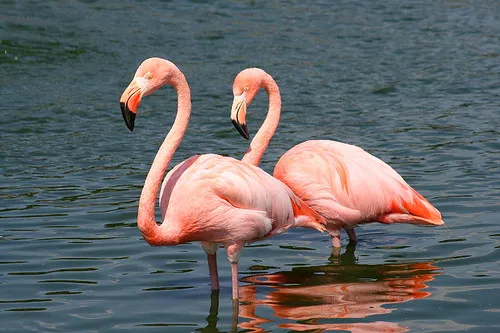By Sukhdev Chhatbar.
Flamingos at Lake Natron, northern Tanzania, home to over 75 per cent of the birds’ world population, face growing dangers that threaten their survival, according to the latest report of the International Union for Conservation of Nature (IUCN).
But this vital habitat is under mounting pressure from climate change, industrial interests and catchment degradation. “Climate change is altering water levels and salinity, making it harder for flamingos to find suitable nesting sites,” explained Mr John Sule, a senior ecologist. “The population of flamingos on Lake Natron is steadily declining as fewer birds return each year due to extreme weather and encroachment.”
The IUCN report points to changes in rainfall patterns that dilute soda lakes, reducing the growth of cyanobacteria, also known as blue-green-algae, which form the primary diet of flamingos. Mr Edmund Shayo, a Tanzanian environmental activist, said: “The rising water levels are diluting the soda lakes, which drastically affects the cyanobacteria that flamingos feed on.”
Local communities living around Lake Natron are also deeply concerned. The Chairman of Engaresero village, Mr James Sapuro Lywangiri, said flamingos are vital for both livelihoods and conservation. “Over 75 per cent of the world’s flamingos are found here, attracting tourists, researchers and students. The revenues support schools, health centres and water infrastructure for our communities.”
Another resident, Mr Lucas Lekide, added: “Lake Natron is our mother — if she is destroyed, we lose everything.” Experts stress that conserving the soda lakes is not only about biodiversity but also about protecting the tourism economy. “The well-being of Lake Natron is a regional and global concern.”
Researchers have long warned of the link between flamingo populations and the abundance of their food sources. A Lake Manyara study by Tanzanian scientists observed that “changes in the Lesser Flamingo numbers were influenced by the changes in the abundance and availability of their preferred food.”
Neighbouring Kenya also faces similar challenges at its Rift Valley lakes, including lakes Nakuru, Bogoria and Elmenteita. Lake Nakuru once hosted more than a million flamingos at a time, turning the shoreline pink with birds, but recent counts have dropped dramatically to less than 200,000 in some seasons due to rising water levels that disrupted the algae they feed on. At Lake Bogoria, where flamingos shifted in search of food, numbers too have fluctuated sharply. Scientists warn that these movements between Kenyan and Tanzanian lakes show how fragile the situation is across borders and why protecting both breeding and feeding sites is essential for the species’ survival.
The IUCN Flamingo Specialist Group urges the two East African neighbours to strengthen conservation action, including better protection of wetlands, improved water management and strict controls against pollution and unsustainable industrial activity. Without immediate intervention, the future of flamingos in the region could be at serious risk.
For Arusha, where flamingos are among the most photographed and admired birds on safari circuits, their decline could deal a blow to the tourism industry. Tour operators in Arusha stress that flamingo spectacles at lakes Manyara, Natron and Eyasi are often a highlight for international visitors, supporting thousands of jobs and generating revenue that flows directly into local communities.
Protecting flamingos is therefore not only a matter of conserving biodiversity but also of safeguarding livelihoods and sustaining the tourism-driven economy on which the region depends. In July 2004, Lake Manyara witnessed one of East Africa’s worst flamingo tragedies when more than 40,000 lesser flamingos were found dead along its shores, with a further thousand recorded at nearby Big Momela in Arusha National Park. Scientists later linked the catastrophe to toxic blooms of blue-green algae (Arthrospira), which flourish when lake levels drop and nutrients concentrate, though disease and other environmental stresses were also suspected. While die-offs have been reported at other soda lakes such as Natron and Kenya’s Bogoria and Nakuru, the 2004 Lake Manyara event remains the most severe in Tanzania’s history and a stark reminder of the fragility of these ecosystems.



